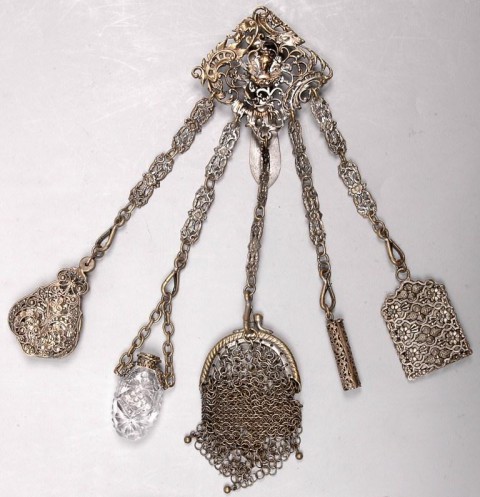Ball chatelaine
karta katalogowa kolekcji
Rzemiosło artystyczne
France (?)
19th century
Brass, die-cut, silver plated, soldered; mirror, transparent glass; celluloid
22 x 6.2 x 1.1 cm
Wil.5909
In Poland, the popular name for this highly original object was szatelenka – from the French chatelaine (which means: wife of the lord of a castle). It was known already in the seventeenth century when women’s robes did not have pockets and the mistress of a large household tied onto her belt buckle (usually on assorted chains) various small items – keys, scissors, a watch - useful in her everyday busy life. Other hold-alls carried specialised equipment for women, e.g. for embroidering; for men they were more massive, with longer chains and, as a rule, with a watch and key attached. The presented unique hold-all, purchased from a private collection, is a variant pinned onto a ball gown and outfitted with a tiny notebook containing several white celluloid pages for jotting down the names of partners planned for successive dances, a sheath for a small pencil, a mirror, a glass bottle for a few drops of perfume, and a tiny bag for several coins. Such szatelenki became particularly popular in the eighteenth and nineteenth century: they were made out of silver and sometimes gold or metals imitating them.
Joanna Paprocka-Gajek
Polecane

Wine, vodka and beer, or old Polish cosmetics
In the former Commonwealth, alcoholic beverages had many applications: they refreshed, cured various ailments, served as seasoning in the kitchen, …

The ideal eighteenth-century ”wedding” gown of Izabela Lubomirska
The portrait of Izabela Lubomirska, née Czartoryska, by Bacciarelli has challenged researchers for long. Although its author added the date …

Peeping mirror
Numerous items that vanished in the course of the last decades include those whose application can be recreated only with …

















